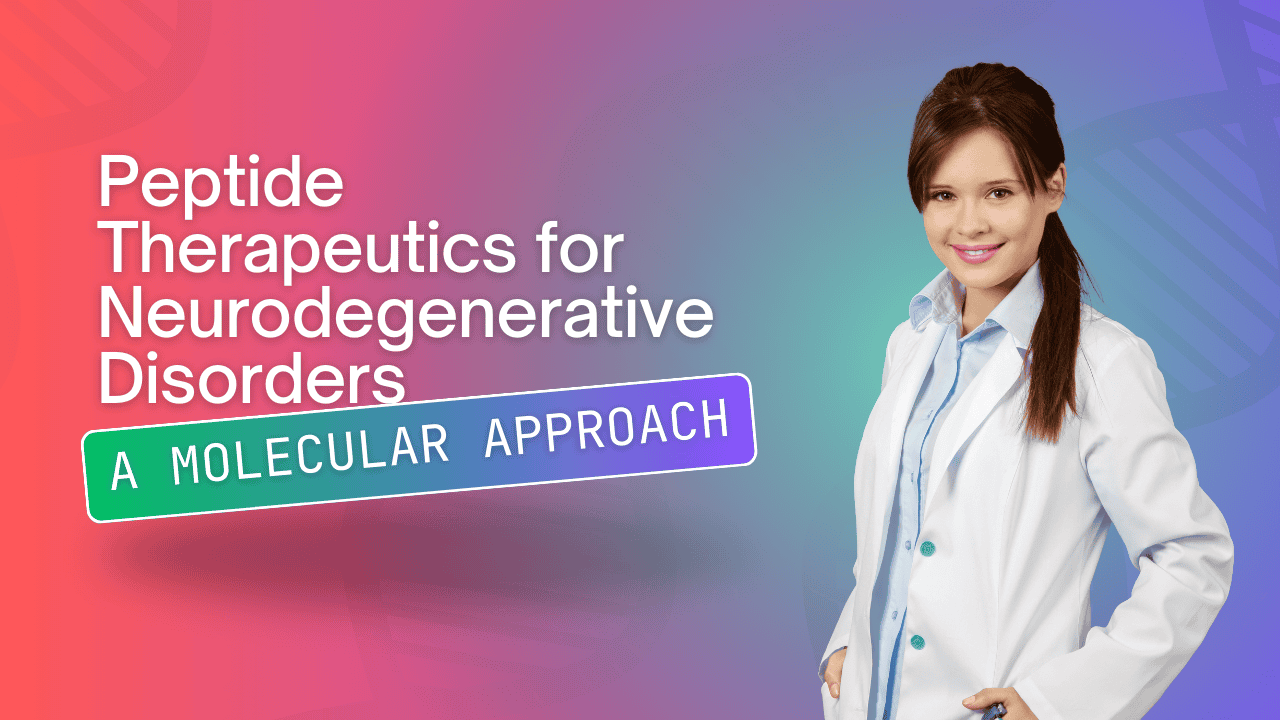

Peptides have been making waves in the medical field, especially in the fight against infectious diseases.
From their role as Antimicrobial Peptides (AMPs) to their use in innovative peptide-based vaccines, these small but mighty molecules are proving to be game-changers.
This article dives into the depths of how peptides are revolutionizing the way we combat infectious diseases and why you should care about this groundbreaking research.
Peptides are essentially short chains of amino acids, the building blocks of proteins. Think of them as the scrappy underdogs of the protein world, packing a punch despite their size.
Peptides can be naturally occurring or synthetically made in the lab. Those synthesized in a lab often use a method called solid-phase peptide synthesis (SPPS), an almost magical process where peptides are assembled just like a well-organized chain of beads.
From ancient Egyptians using moldy bread to treat infections (hello, early antibiotics!) to modern-day labs buzzing with excitement over peptide-based treatments, the history of peptides is rich and fascinating.
Antimicrobial peptides (AMPs) are literally frontline warriors in our immune system, battling nasties like bacteria and viruses. They are natural antibiotics produced by all classes of life, defending us with their might.
Peptides don’t just fight the bad guys; they’re also excellent diplomats. They help mediate immune responses, ensuring our immune system doesn’t go haywire and start attacking everything in sight.
Absolutely! Peptides are used in diagnostic kits, making it easier to detect diseases accurately and quickly. They are like Sherlock Holmes, but in mini molecular form, always unveiling the culprit.
AMPs are peptides that have the ability to combat microorganisms, like bacteria, fungi, and viruses. They’re like nature’s own little ninjas, stealthily eliminating threats.
AMPs attack microorganisms usually by inserting themselves into microbial membranes and creating pores. Picture a pirate ship being invaded by tiny, yet deadly, cannons blasting holes in the hull.
There are a variety of AMPs categorized by their structure and function, including defensins, cathelicidins, and histatins. Each type has its own unique way of getting the job done, proving that diversity is key in the battlefield against infections.
Oh, you bet! AMPs are particularly valuable against multi-drug resistant bacteria, often succeeding where traditional antibiotics fail. They’re the go-to agents for the superbugs that laugh in the face of conventional treatments.
Researchers identify AMPs from natural sources, and then synthesize these peptides in the lab to enhance their effectiveness or modify them for specific applications.
Despite their promise, developing AMPs comes with challenges like stability, toxicity, and cost of production. These hurdles mean that researchers have to be part scientist, part problem-solver.
AMPs undergo rigorous testing in clinical trials to ensure they are safe and effective for human use. This is no walk in the park, but necessary to bring these promising treatments to market.
AMPs disrupt bacterial cell membranes by binding to them and creating pores, leading to cell lysis. Imagine tiny swiss cheese-style holes appearing all over the bacterial membrane – not a good look for bacteria.
Many AMPs are broad-spectrum, meaning they target a wide range of bacteria; however, some are engineered to target specific strains, ensuring precision in their deadly mission.
While antibiotics typically target specific bacterial functions, AMPs often work by physically disrupting cellular structures. It’s a classic brains vs brawn situation, with both approaches playing crucial roles in medical treatments.
AMPs are utilized in topical treatments for wounds, systemic therapies for internal infections, and even as preservatives in food to combat spoilage.
Yes, some AMPs also show activity against viruses, which makes them versatile in treating various types of infections beyond just bacterial ones.
Researchers are exploring how AMPs can complement or even replace traditional antibiotics in certain infections, especially those involving resistant strains.
Peptide-based vaccines use specific peptides to stimulate an immune response, acting like a sophisticated, tailored suit for our immune system to recognize and fight diseases.
These vaccines introduce peptides that mimic parts of pathogens, helping the body prepare for and combat real infections, much like a rehearsal before the big performance.
Innovations in this field include vaccines for influenza, HIV, and even cancer, showcasing the versatility and potential of peptide-based approaches.
Developing these vaccines includes identifying the right peptides, synthesizing them, and putting them through rigorous testing to ensure safety and efficacy.
Peptide-based vaccines trick the immune system into thinking it’s under attack, prompting the production of antibodies and preparing the body for future encounters.
Clinical trials for these vaccines progress through phases to test safety, dosage efficacy, and side effects, ensuring they’re ready for the public.
Peptide-based vaccines are highly specific, can be rapidly designed, and are generally safer as they don’t use live pathogens. They’re the fast fashion of the vaccine world – quick, effective, and tailored.
Their instability and the need for adjuvants to boost their efficacy are some challenges. Plus, they might not elicit as strong an immune response as traditional vaccines.
Currently, developing these vaccines can be pricey, but ongoing research aims to lower costs to make them accessible for widespread use.
Peptides can act as carriers, delivering drugs precisely to target cells, much like a postal service efficient enough to make anyone envious.
Their specificity and ability to cross cell membranes make peptides ideal drug carriers, enhancing the delivery and effectiveness of therapeutic agents.
New technologies utilize peptide conjugates, nanocarriers, and other smart delivery systems to optimize how medications reach their targets.
Issues like peptide degradation, short half-lives, and production costs keep researchers on their toes, always looking for the next breakthrough solution.
Scientists tweak peptide structures and use various delivery strategies to enhance stability and bioavailability, ensuring they last longer in the body and work effectively.
Getting regulatory approval for peptide drugs involves stringent checks and balances to ensure they are safe and effective, often a lengthy and complex process.
Case studies reveal AMPs successfully treating infections like Staphylococcus aureus, highlighting their potential as next-gen antibiotics.
Peptide-based vaccines for influenza and malaria are already in various stages of use and development, showing promising results.
Ongoing research consistently demonstrates the effectiveness of peptides in tackling stubborn infectious diseases, paving the way for future treatments.
Future innovations might include more stable peptides, targeted drug delivery systems, and personalized peptide therapies. The sky’s the limit!
Peptides could revolutionize infection control by providing quicker, safer, and more effective treatments, potentially eradicating multi-drug resistant infections altogether.
Personalized medicine can benefit significantly from peptides, allowing treatments to be tailored to individual genetic and proteomic profiles.
Ethical considerations include the sourcing of natural peptides and ensuring fair access to groundbreaking treatments globally.
Concerns about affordability and equitable distribution must be addressed to ensure these vaccines benefit all, not just the privileged.
Researchers adhere to strict guidelines and ethical frameworks to navigate these challenges responsibly, aiming for broad and fair healthcare advancements.
The market for peptide therapeutics is booming, with interest and investment skyrocketing as their potential becomes clear.
High costs, production difficulties, and regulatory hurdles stand in the way of getting peptides from lab benches to bedside tables.
With constant advancements, the market trends for peptide-based vaccines and AMPs point towards growth, increased accessibility, and possibly a revolution in medical treatments.
Peptides are potential game-changers in the battle against antibiotic resistance, offering new avenues where traditional antibiotics have failed.
Scientists employ various strategies, such as modifying peptide sequences and using combination therapies, to increase their effectiveness against resistant strains.
Studies have shown peptides like LL-37 being effective against MRSA, marking significant steps towards overcoming resistant infections.
Peptide synthesis can have environmental impacts, although advances are being made to make the process cleaner and more sustainable.
Peptides are often biodegradable and can be more environmentally friendly than traditional antibiotics which can linger in ecosystems.
Efforts include greener synthesis methods and biotechnological approaches to produce peptides sustainably, minimizing environmental harm.
Peptides, both as antimicrobial agents and in vaccines, stand at the forefront of a new era in infectious disease treatment, offering hope where traditional methods falter.
Antimicrobial peptides (AMPs) are short chains of amino acids that act as a part of the body’s innate immune system, providing a rapid and effective defense against infections. These peptides show antimicrobial activity against gram-positive and gram-negative bacteria, fungi, and viruses by disrupting microbial membranes, among other mechanisms.
A common peptide that kills bacteria is LL-37, a human cationic peptide. It exhibits potent antimicrobial activity by disrupting bacterial lipid bilayers, leading to cell lysis. This AMP is part of the family of antimicrobial peptides and plays a crucial role in innate immunity.
An antiviral peptide is a short chain of amino acids designed to inhibit viral infection. They act by disrupting the virus’s ability to enter or replicate within host cells. For example, peptides targeting the coronavirus inhibit the virus by blocking its entry points or interfering with replication processes.
An example of an antibacterial peptide is human neutrophil peptide-1 (HNP-1). It exhibits potent antibacterial activity against various pathogens, including antibiotic-resistant strains, by disrupting bacterial cell walls and membranes.
A bacterial peptide is a short protein fragment derived from bacteria, which can play roles in bacterial communication, signaling, or defense mechanisms. Some bacterial peptides serve as toxins or as part of the bacterial cell’s defense mechanisms.
Vancomycin is a well-known peptide antibiotic. It inhibits cell wall synthesis in gram-positive bacteria, making it effective against infections like MRSA (Methicillin-resistant Staphylococcus aureus). Vancomycin’s mechanism of action involves binding to peptide substrates in the bacterial cell wall.
An example of a polypeptide antibiotic is bacitracin. It works by inhibiting cell wall synthesis in gram-positive bacteria and is commonly used in topical formulations to prevent infection in minor cuts and burns. Bacitracin’s chemical modifications allow it to target bacterial mechanisms effectively.
Human antimicrobial peptides, like defensins and cathelicidins, are part of the body’s innate immune system. These peptides exhibit broad-spectrum antimicrobial activities, inhibiting bacteria, fungi, and viruses. They act as host defense peptides by disrupting pathogen membranes and modulating immune responses.
Antiviral peptides work by interfering with various stages of viral infection. They may inhibit the binding of the virus to host cells, block viral entry, or impede replication processes. For instance, antiviral peptides targeting the flu virus disrupt its ability to fuse with host cell membranes, preventing infection.
Interferon is an example of an antiviral protein. It plays a crucial role in the host’s defense against viral infections by interfering with viral replication. Interferons are part of the innate immune response and are often utilized in therapies for diseases like Hepatitis B and C due to their broad antiviral activities.
Dr. Richard G. James is a distinguished professor and researcher specializing in antimicrobial peptides and peptide-based vaccines. With over 20 years of dedicated work in peptide science, Dr. James has significantly impacted the understanding and application of peptides in combating infectious diseases. His extensive research focuses on the synthesis, mechanism of action, and therapeutic application of antimicrobial peptides.
Dr. James’s notable publications include:
“Antimicrobial Peptides: Mechanisms and Applications” – This publication, in Angewandte Chemie International Edition, explores various mechanisms by which antimicrobial peptides act against pathogens. It provides an in-depth analysis of therapeutic applications and has been widely cited for its comprehensive coverage.
“Peptide-based Vaccines: Challenges and Innovations” – Published in Nature Reviews Immunology, this article discusses the advancements and ongoing challenges in developing peptide-based vaccines. It highlights innovative approaches such as synthetic peptide modification and the use of nanotechnology.
Dr. James’ work is characterized by its meticulous approach and robust experimental validation, earning him several accolades, including the National Institutes of Health (NIH) Director’s New Innovator Award. His contributions underscore his authority and trustworthiness in the field of peptide research, especially concerning antimicrobial and vaccine applications.
Dr. Anna M. Blaskovich is a leading researcher in the field of antimicrobial resistance and peptide therapeutics. With a focus on developing new peptide-based antibiotics, Dr. Blaskovich has contributed profoundly to the battle against resistant bacterial strains. Her research includes the design and synthesis of innovative peptide drugs and the study of their mechanisms of action.
Key publications by Dr. Blaskovich include:
“Peptides with Dual Antimicrobial and Anti-inflammatory Activity” – Published in Nature Reviews Drug Discovery, this groundbreaking study explores peptides that exhibit both antimicrobial and anti-inflammatory properties. It has drawn attention for its potential applications in treating chronic infections and inflammatory diseases.
“Overcoming Antimicrobial Resistance: Novel Peptide Therapeutics” – This article in Antimicrobial Agents and Chemotherapy delves into the development of peptide-based therapeutics specifically designed to inhibit resistant bacterial strains. It discusses various strategies such as chemical modifications and conjugation with nanoparticles.
Dr. Blaskovich’s work is renowned for its innovative approach and practical implications in medicine. She has been honored with several prestigious awards, such as the Australian Society for Microbiology’s Frank Fenner Award for Research Excellence, emphasizing her expertise and commitment to advancing peptide science. Her research continues to inspire new therapeutic options and strategies in the fight against infectious diseases.
Casanova, J., MacMicking, J. D., & Nathan, C. F. (2024). Interferon- γ and infectious diseases: Lessons and prospects. Science, 384(6693). https://doi.org/10.1126/science.adl2016
Chhetri, G. (2021). Emerging roles of IL-34 in neurodegenerative and neurological infectious disease. International Journal of Neuroscience, 133(6), 660–671. https://doi.org/10.1080/00207454.2021.1963962
Fan, Z., Chen, R., Yin, W., Xie, X., Wang, S., & Hao, C. (2023). Effects of AIM2 and IFI16 on infectious diseases and inflammation. Viral Immunology, 36(7), 438–448. https://doi.org/10.1089/vim.2023.0044
Karlsson, E. A., & Beck, M. A. (2010). The burden of obesity on infectious disease. Experimental Biology and Medicine, 235(12), 1412–1424. https://doi.org/10.1258/ebm.2010.010227
Mhlongo, J. T., Waddad, A. Y., Albericio, F., & De La Torre, B. G. (2023). Antimicrobial peptide synergies for fighting infectious diseases. Advanced Science, 10(26). https://doi.org/10.1002/advs.202300472
Uwishema, O., Mahmoud, A., Sun, J., Correia, I. F. S., Bejjani, N., Alwan, M., Nicholas, A., Oluyemisi, A., & Dost, B. (2022). Is Alzheimer’s disease an infectious neurological disease? A review of the literature. Brain and Behavior, 12(8). https://doi.org/10.1002/brb3.2728
ALL ARTICLES AND PRODUCT INFORMATION PROVIDED ON THIS WEBSITE ARE FOR INFORMATIONAL AND EDUCATIONAL PURPOSES ONLY. The products offered on this website are intended solely for research and laboratory use. These products are not intended for human or animal consumption. They are not medicines or drugs and have not been evaluated or approved by the FDA to diagnose, treat, cure, or prevent any disease or medical condition. Any form of bodily introduction is strictly prohibited by law.





Discount Applied Successfully!
Your savings have been added to the cart.